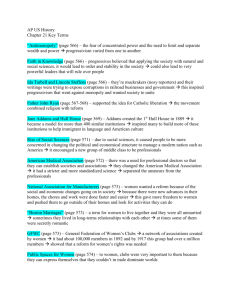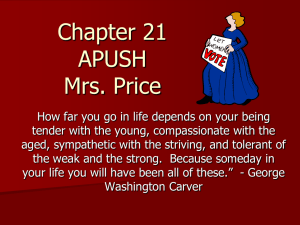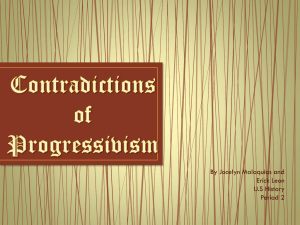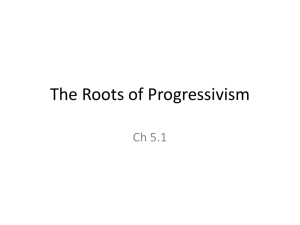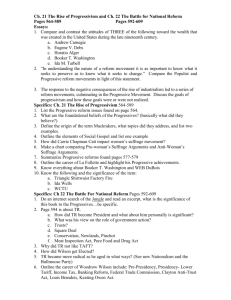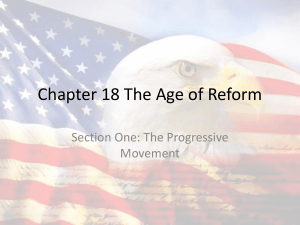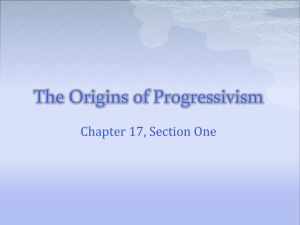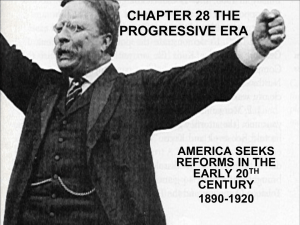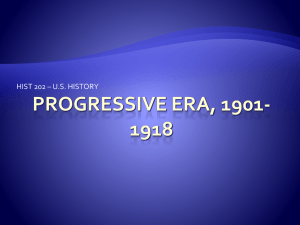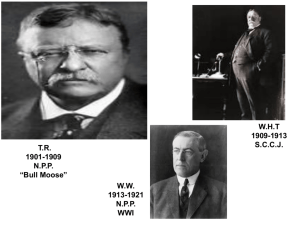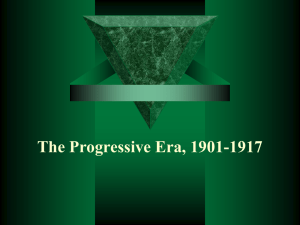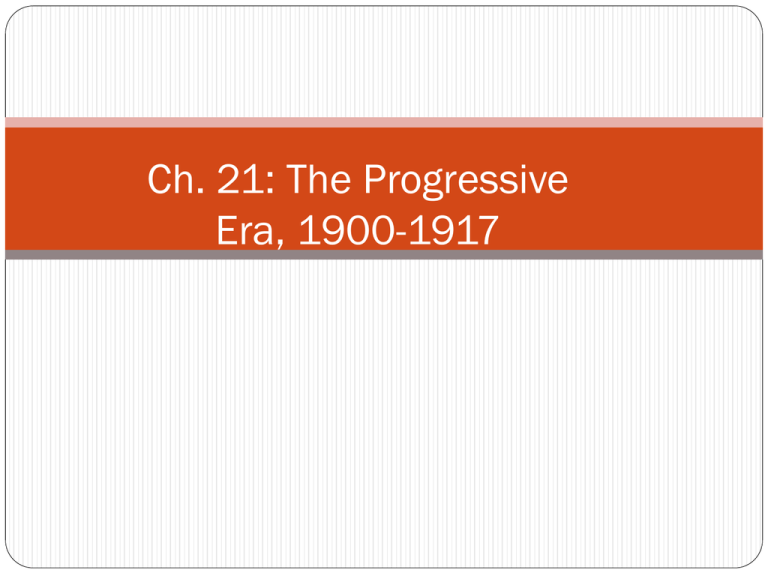
Ch. 21: The Progressive
Era, 1900-1917
How did intellectuals, novelists, and journalists help lay the
groundwork for the progressive movement?
What problems of the new urban-industrial order particularly
disturbed progressives, and how did they address these
problems?
How did progressive reform affect ordinary Americans,
including workers, women, immigrants, city dwellers, and
African Americans?
As progressivism emerged as a national movement, which
politicians and issues proved most important?
How did progressivism change Americans’ view of the proper
role of government?
The Many Faces of Progressivism
The rapid growing middle class (native-born, white, and
Protestant)
White-collar work jumped from 5.1 to 10.5 million
between 1900-1920
Professional societies began to emerge (Bar, Advertising,
Professors)
People had new allegiances, certification, licensing,
membership and standardization
With these new identities came an effort to make their
influence felt
College educated women tripled and the divorce
rate crept up – the “New Woman” emerged
The initial push for reform came from women’s
clubs, settlement houses, and private groups, not
from political parties
Even the urban political machines got involved later
No matter, progressivism was a series of political
and cultural responses to industrialization and its byproducts
They were journalists, academics, social theorists,
urban dwellers; reformers, not radicals
They sought the following:
Regulation of business
Protection of workers and the urban poor
Government reform
Improved morality
All with the use of science and expert knowledge
Intellectuals Offer
New Social Views
Thorstein Velben - The Theory of the Leisure
Class
William James – Pragmatism
Herbert Croly – The Promise of American
Life and the New Republic
Jane Addams – Democracy and Social Ethics
John Dewey – Democracy and Education
Oliver Wendell Holmes – The Common Law
conspicuous consumption
truth comes from experience, not
theorizing
Call for an activist government
Each individual’s well-being depends
on the well-being of others
The key institution for a more humane and
cooperative social order was the public school
(7 mil.- 23 mil.: 1870-1920)
Law must evolve as society changes
Novelists, Journalists, and Artists
Spotlight Social Problems
Frank Norris – The Octopus
Theodore Dreiser – The Financier
McClure’s and Collier’s
Lincoln Steffens – Shame of the Cities
Ida Tarbell – The History of Standard Oil
Lewis Hines photographs
Muckrakers
California’s railroad vs. wheat farmers
Tycoon who lacks social conscience
Muckraking journalists
Exposing city corruption
Obvious
Reforming the Political Process
Samuel M. (Golden Rule) Jones of Toledo, OH
Profit sharing in factories, playgrounds, free
kindergarten, lodging for transients
New styles of governing like the city manager
system (many times changing after natural
disasters)
These new systems brought in experts to run the
city like a business
However, government changes sometimes
reduced the power of the immigrant classes
Electoral reform was popular
Secret ballot
direct primary
initiative
referendum
Recall
All of these weakened party loyalty
and voter participation (individual
activity decreases while interest group
activity increases)
Regulating Business, Protecting
Workers
J.P. Morgan’s U.S. Steel Company owned 80%
of the nation’s production; he also had the one
major farm-implement company, International
Harvester
Workers wages did increase from $532 to $687
by 1915 (annual wage)
However, whole families had to work
Average work day: 9 ½ hours
1907 – 4,534 railroad workers died; 3,000
miners
Frederick Winslow Taylor’s Scientific Management
focuses on efficiency: standardization
Reformers felt that since business benefited from
government’s high tariffs, government should
regulate these businesses
Wisconsin’s Robert “Fighting Bob” La Follette led
the way
Direct primary, railroad regulatory commission,
increased corporate taxes, limited campaign
spending, legislative reference library
By 1907, thirty states had child labor
laws
1903, Oregon limited the work-day of
women to 10 hrs.
Political bosses even got involved,
especially after the Triangle Shirtwaist
Factory Fire
Making Cities More Livable
By 1920, the urban population surpasses 20%
There are campaigns for parks, streetlights,
laws against billboards and electric wires
Concern for public health (they had a socialclass agenda)
Typhoid Mary (Irish cook)
Infant mortality drops
Antismoke campaign
Progressivism and Social
Control
Self-righteous nature of the Progressive
Movement (pitted native-born vs. immigrant)
Alcohol
Prostitution
Mann Act (1910) – can’t transport a woman across
state lines for “immoral purposes”
Drugs
Narcotics Act (1914) – also known as the Harrison Act,
bans the distribution of morphine, cocaine, and other
addictive drugs
Immigration Restriction and
Eugenics
NW vs. SE Europeans
Immigration Restriction League and the American
Federation of Labor fear job competition and
endorse restriction
Literacy bills passed then vetoed repeatedly;
overridden in 1917
Sterilization of “inferior” genetic stock
Proposal: Eugenics gave a scientific justification to
anti-immigrant sentiment
Racism and Progressivism
The Great Migration to the Northern cities
1.4 million African American in the North by
1920
Fed up in the South; growth of the cities;
Birth of a Nation (glorifies the KKK); 75
lynchings occur yearly
W.E.B. du Bois vs. Booker T. Washington
1905- Niagara Movement (meet annually and
eventually form the NAACP)
Revival of the Women’s Suffrage
Movement
1910-Women can vote in WY, CO, UT, and ID
Middle-class women upset that immigrant men can
vote
GB movement helped fuel U.S. women
California campaign
Municipal reforms, public-school issues
Joined with labor leaders and male progressives
1911 – suffrage in CA
“Organized Womanhood” however had limits
Elite and middle-class women mostly
National American Woman Suffrage Association
Susan B. Anthony retires and Carrie Chapman
Catt takes over
They adopted the Winning Plan: grassroots
organization with tight central coordination
Lobbied legislatures, held parades, ran newspaper
ads, put up posters, held fundraisers, arranged
photo ops, distributed items emblazed with
suffrage message
1917- NY approved a woman-suffrage
referendum
NAWSA membership was mostly white,
native-born and middle class
“Antis”
Alice Paul (who studied the British approach)
grew impatient with the state by state
method
She formed the Women’s Party
She targeted the White House and the
Democratic Party
Accused Wilson of being a hypocrite
Enlarging “Woman’s Sphere”
Women were active in Progressive reforms (it was
natural)
Contraception and birth-control information were
key issues
1914- Margaret Sanger began her crusade
Her journal The Woman Rebel was “obscene”
1916- she opened the first birth control clinic
1921- founded the American Birth Control League
Mary Ware Dennett’s The Sex Side of Life
was declare obscene
It was a pamphlet for youth
She lobbied efforts to amend obscenity
laws
She argued that contraception should by
free (Sanger thought you should have them
prescribed)
Workers Organize;
Socialism Advances
American Federation of Labor (AFL) grew to 4 million
by 1920; but only in skilled trades and only 20% of the
workforce
Industrial Workers of the World (IWW; Wobblies), led
by Big Bill Haywood; mostly western miners,
lumbermen, fruitpickers and itinerant laborers
Socialism gains followers
End to capitalism
Public ownership of factories, RR, utilities,
communications systems
1900- Socialist Party of America
The Masses – radical magazine
Height was in 1912: Debs receives 900,000 votes
National Progressivism
Phase I: Roosevelt and Taft,
1901-1913
1905: La Follette goes to Washington as a
Senator
TR – cowboy, state assemblyman, New York
City police commissioner, U.S. civil serviceman,
Asst. Sec. of the Navy
1902 Pennsylvania Coal Strike: United Mine
Workers Union; arbitration and the threat of a
govt. takeover; miners get 10% wage increase and
a reduction of hours to 9
Trustbusting
Suit against the Northern Securities Company (5-
4 in favor of dissolution)
He announced his “square deal”
During his presidency, 43 antitrust lawsuits;
Standard Oil is broken up and American Tobacco
Company is reorganized
During TR’s second term he turned to RR
regulation
Hepburn Act (1906) – set maximum RR rates and free
passes; govt. could examine financial records
Consumer Protection and Racial Issues
Pure Food and Drug Act
Meat Inspection Act
Booker T. Washington to the White House
Brownsville Incident
Dishonorable discharge of three companies, without
due process
Rescinded in 1971
Environmentalism Progressive-Style
1891- 35 million acres of public lands for national
forests had be set aside
Boy Scouts formed in 1910; Girl Scouts in 1912
Gifford Pinchot (head of U.S. Forest Service)
stresses conservation
John Muir stresses preservation
1902- National Reclamation Act: water
management in arid western regions; construction
of dams and irrigation projects
Newlands Act required farmers to repay the
construction costs
Antiquities Act (1906) - protected
archeological sites
TR helps create 53 wildlife reserves, 16
national monuments, and 5 national parks
1916- National Park Service set up
Taft in the White House
Running on a conservative ticket, he beats William
Jennings Bryan
Taft actually prosecutes more anti-trust cases than
TR, but he doesn’t garner the publicity
Reform turns to Congress and the Insurgents (La
Follette is one)
Payne-Aldrich Tariff makes them mad
Ballinger-Pinchot Affair: makes matters worse
TR returns and supports Insurgent Candidates in
1910 and proposes the New Nationalism
Election of 1912
Taft (R), TR (Bull Moose
Progressive), Wilson (D), and Debs
(S)
National Progressivism
Phase II: Woodrow Wilson,
1913-1917
Tariff and Banking Reform
Underwood-Simmons Tariff lowers rates by 15%
Federal Reserve Act of 1913- 12 regional banks and the
FRB
Regulating Business; Aiding Workers and Farmers
Federal Trade Commission Act – FTC is a watchdog
Clayton Antitrust Act- listed actions that would bring a
lawsuit such as price discrimination and exclusive
dealings (was ineffective due to business links)
Federal Highway Act – matching funds to states
Keating Owen Act – banned from interstate commerce
products manufactured by child labor (but declared
unconstitutional)
Progressivism and the
Constitution
Muller v. Oregon – women’s 10-hr. workday
Louis Brandies was the first Jewish Supreme
Court justice
16th Amendment – income tax
17th Amendment – direct election of Senators
18th Amendment – Prohibition
19th Amendment –Women’s right to vote
Ch. 21 Notes Quiz
1. What were three goals of the Progressives?
2. What book did John Dewey write? Describe its
content.
3. What was the significance of McClure's and
Colliers?
4. What is a referendum?
5. What were the limits of the women’s suffrage
movement? Give two (not just men didn’t like
them)
6. Who opened America’s first birth control
clinic?

